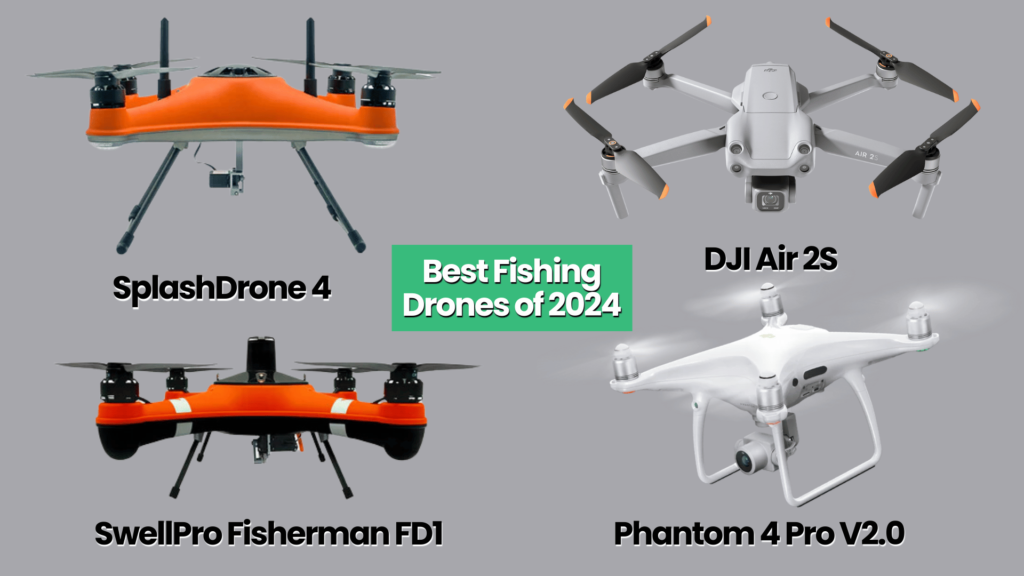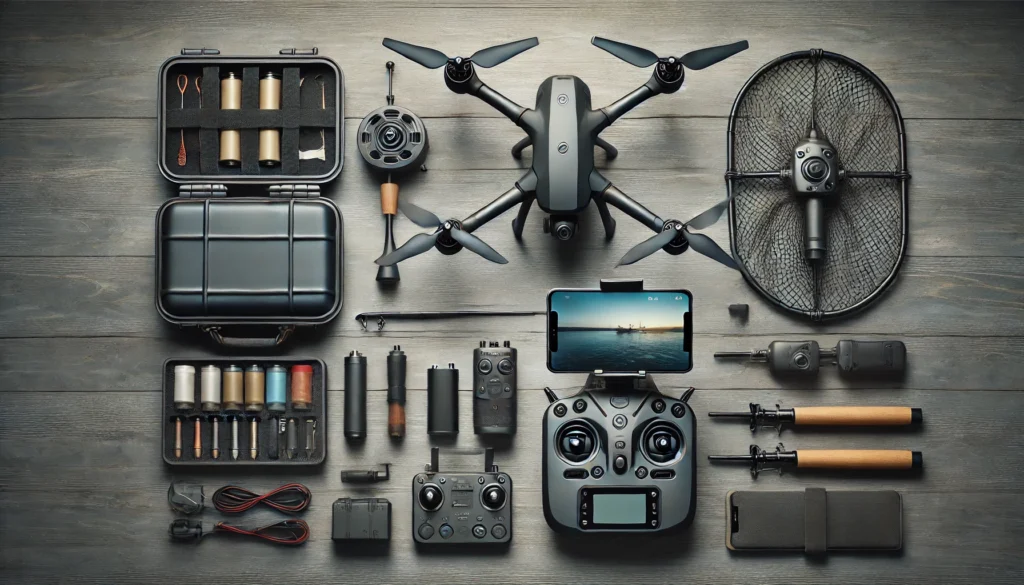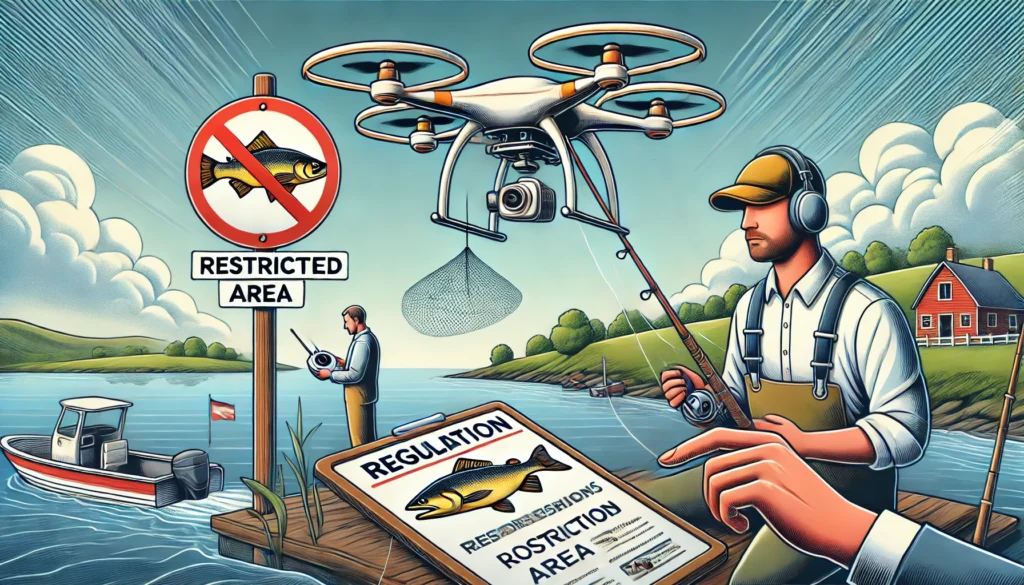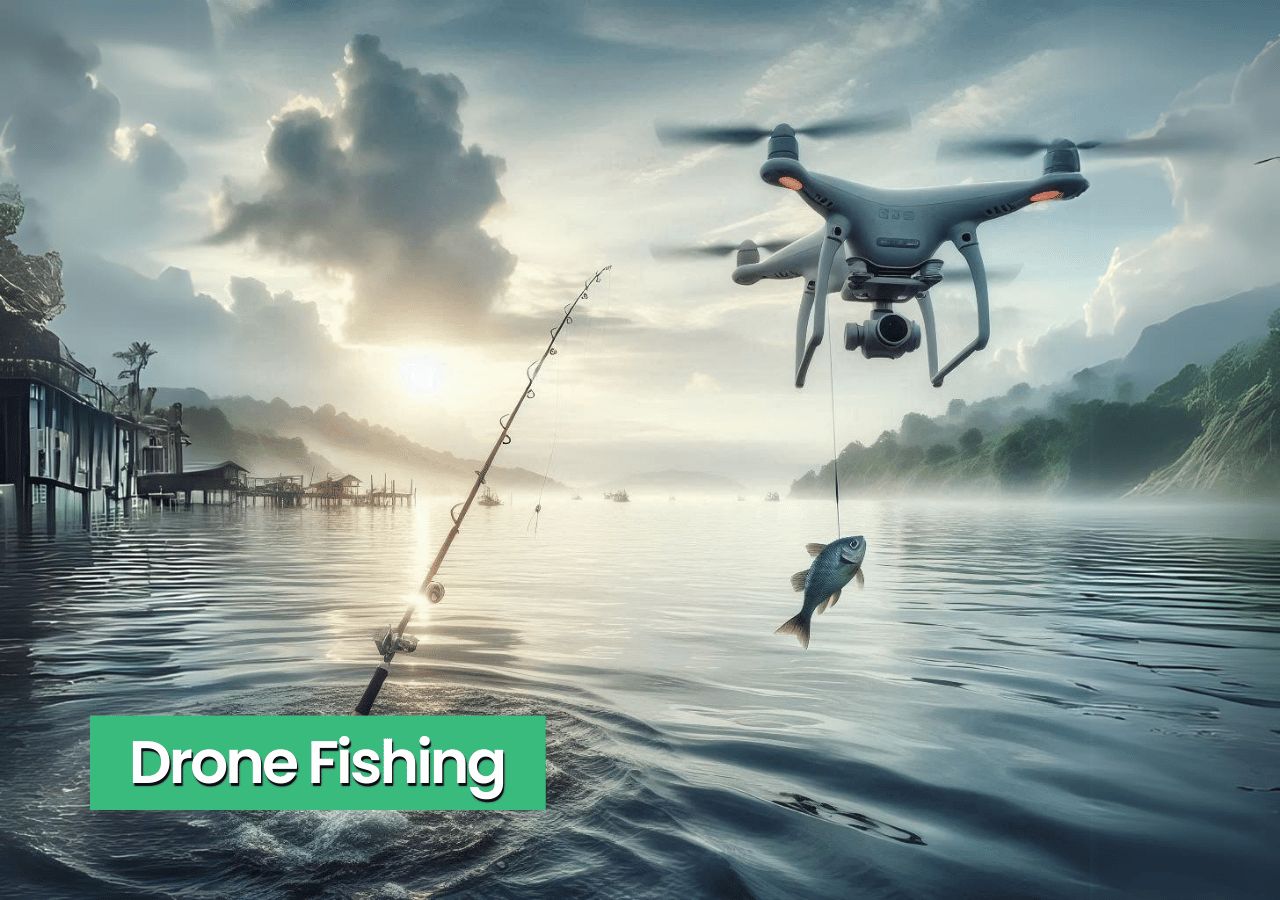Introduction to Drone Fishing
Drone fishing is revolutionizing the way anglers approach their favorite pastime. But what exactly is drone fishing? Simply put, it involves using drones to cast fishing lines farther than humanly possible, allowing access to previously unreachable fishing spots. This method is becoming increasingly popular due to its efficiency and the exciting new opportunities it presents for both novice and experienced fishers.
History and Evolution of Drone Fishing
Drone fishing has come a long way since its inception. Initially, it was a niche activity practiced by a few enthusiasts. However, with advancements in drone technology and the increasing affordability of drones, it has become a mainstream fishing technique. Early adopters used modified recreational drones, but now, specialized fishing drones with advanced features are readily available.
Why Drone Fishing is the Future of Angling
The appeal of drone fishing lies in its ability to overcome the limitations of traditional fishing methods. With drones, anglers can target precise locations, cast over long distances, and explore new fishing grounds. This technology not only enhances the fishing experience but also makes it more accessible to people of all skill levels.
Benefits of Drone Fishing
Enhanced Fishing Range
One of the most significant advantages of drone fishing is the ability to extend your fishing range. Traditional casting methods are limited by human strength and skill, but drones can fly your bait hundreds of meters out to sea, targeting areas rich in fish that were previously out of reach.
Precision and Efficiency
Drones offer unmatched precision when it comes to dropping your bait. With GPS technology and stable flight capabilities, you can position your bait exactly where you want it, increasing the chances of a successful catch. This precision also means less time spent on missed casts and more time enjoying the thrill of fishing.
Accessibility for All Skill Levels
Whether you’re a seasoned angler or a complete beginner, drone fishing is accessible to everyone. The technology behind drones simplifies the fishing process, making it easier to learn and master. For those who may struggle with traditional casting techniques, drones provide an alternative that levels the playing field.
Environmental Benefits
Drone fishing can be less invasive than traditional methods. By precisely targeting specific areas, it reduces the likelihood of disturbing large sections of marine life. Additionally, drones can help monitor and protect fishing environments, contributing to more sustainable fishing practices.
Types of Drones for Fishing
Standard Drones vs. Specialized Fishing Drones
Many recreational drones can be adapted for fishing with the right attachments and modifications. These drones are typically more affordable and can still offer excellent performance for casual anglers. However, specialized fishing drones are designed with features like waterproofing, extended battery life, and stronger payload capacities to handle the demands of fishing. They often come with built-in cameras and GPS systems, making them ideal for more advanced fishing techniques.
Best Fishing Drones of 2024

- SwellPro SplashDrone 4: Known for its waterproof design and durability, making it perfect for rough conditions.
- SwellPro Fisherman Drone FD1: A budget-friendly option with excellent features for beginner drone fishers.
- DJI Air 2S: Offers high-quality camera capabilities for scouting and precision fishing.
- DJI Phantom 4 Pro V2.0: A premium drone with advanced features, ideal for surf fishing and capturing stunning aerial footage.
Key Features to Look for in a Fishing Drone
When choosing a drone for fishing, consider the following key features:
- Payload Capacity: The weight the drone can carry, including bait and fishing line.
- Flight Time: Longer battery life allows for extended fishing sessions.
- Range: The maximum distance the drone can travel from the controller.
- Stability: Essential for maintaining control in windy or turbulent conditions.
- Waterproof or Water-Resistant: Protects the drone from water damage.
- GPS & Return to Home: Ensures the drone can find its way back safely.
- Camera Quality: Higher resolution cameras provide better scouting and positioning.
- Live Video Feed: Allows real-time viewing and control.
- Bait Release Mechanism: Ensures precise bait deployment.
- Automatic Flight Modes: Simplifies complex maneuvers.
- Durability: Robust construction to withstand harsh conditions.
- Portability: Ease of transport and setup.
- Safety Features: Obstacle avoidance and emergency landing capabilities.
Choosing the Right Drone Fishing Kit

Essential Components of a Drone Fishing Kit
A typical drone fishing kit includes the drone itself, a release mechanism for the fishing line, a camera for navigation, and a remote control. Some kits also come with additional accessories like extra batteries and carrying cases.
Recommended Kits for Beginners and Pros
For beginners, kits like the SwellPro SplashDrone 4 and the DJI Phantom 4 Pro are excellent choices. These kits offer a good balance of ease of use, durability, and advanced features that can help you get started with drone fishing without overwhelming you.
How to Drone Fish: Step-by-Step Guide
Preparing Your Drone
Start by ensuring your drone is fully charged and all components are in working order. Attach the release mechanism securely and test it to make sure it functions correctly.
Setting Up Your Fishing Line
Attach your fishing line to the release mechanism. Make sure the line is properly threaded and secured to avoid any tangles or mishaps during flight.
Operating the Drone for Fishing
Launch your drone and fly it to the desired location. Use the camera to help navigate and position your bait accurately. Once in position, release the bait and carefully monitor the line for any signs of a catch.
Using Your Drone to Scout for Fish
Drones equipped with high-quality cameras can be used to scout for fish from the air. Fly over potential fishing spots and use the live video feed to identify schools of fish or promising areas.
Advanced Drone Fishing Techniques
Using Sonar for Fish Detection
Some advanced drones come equipped with sonar technology, allowing you to detect fish underwater. This feature can significantly improve your chances of locating and catching fish.
Night Fishing with Drones
Night fishing with drones is becoming increasingly popular. Equip your drone with LED lights and use its camera to navigate and drop bait in the dark.
Fishing from a Boat with a Drone
Using a drone to fish from a boat combines the mobility of boating with the extended reach of drone fishing. This method can help you access deep waters and remote fishing spots.
Best Practices and Tips for Successful Drone Fishing
Best Times and Locations for Drone Fishing
Research the best times and locations for drone fishing in your area. Early mornings and late evenings are often the most productive times, and areas with abundant fish populations will increase your chances of a successful catch.
Common Mistakes to Avoid
- Avoid flying your drone too close to the water surface.
- Do not overload your drone with too heavy a bait.
- Regularly check and maintain your drone to prevent malfunctions.
Maintenance and Care for Your Drone
Regularly inspect your drone for any signs of wear and tear. Check the propellers, battery, and release mechanism to ensure everything is in good working order. Clean your drone after each use, especially if you’ve been fishing in saltwater, to prevent corrosion.
Legal Considerations and Safety Tips
Is Drone Fishing Legal?
Drone fishing legality varies by region. Always check local laws and regulations before you start. Some areas may have restrictions on where you can fly drones or specific rules about fishing practices.
Rules and Regulations by Region
In some countries, drone fishing is completely legal, while others may have strict regulations or outright bans. For example, in the United States, the Federal Aviation Administration (FAA) governs the use of drones, and specific states may have additional rules. In Australia, drone fishing is popular, but regulations vary by state. Always research the laws in your area before heading out.
Safety Precautions and Training
Always follow the manufacturer’s guidelines for safe drone operation. Keep your drone within line of sight and avoid flying in restricted areas. Consider taking a drone piloting course to improve your skills and knowledge.
Cost of Fishing Drones and Kits
Price Range and Considerations
The cost of fishing drones and kits can vary widely depending on the brand and features. Basic kits for beginners might start around $500, while more advanced kits with specialized fishing drones can range from $1,000 to $3,000 or more. Investing in a quality kit can enhance your fishing experience and provide better durability and functionality.
Cost vs. Benefit Analysis
Evaluate the cost versus the benefits when choosing a drone fishing kit. Higher-end models may offer advanced features that can improve your fishing success, but more affordable options can still provide excellent performance for casual anglers.
Environmental and Ethical Considerations

Impact on Wildlife and Ecosystems
Be mindful of the environment while drone fishing. Avoid disturbing wildlife and adhere to local regulations regarding protected areas. Using drones responsibly can help minimize the impact on ecosystems and promote sustainable fishing practices.
Best Practices for Sustainable Drone Fishing
Practice catch and release to preserve fish populations. Avoid overfishing in any one area and respect local wildlife. By following ethical guidelines, you can enjoy drone fishing while protecting the environment.
Community and Educational Resources
Online Communities and Forums
Join online communities and forums dedicated to drone fishing. These platforms offer valuable insights, tips, and support from fellow drone fishers. Some popular forums include Reddit’s drone fishing community and specialized Facebook groups.
Educational Programs and Initiatives
Look for educational programs and initiatives that promote safe and sustainable drone fishing practices. Many organizations offer workshops, webinars, and courses to help you improve your skills and knowledge.
Drone Fishing Videos and Tutorials
Where to Find the Best Tutorials
YouTube is an excellent resource for drone fishing tutorials. Channels like “Fishing with Drones” and “Drone Fishing Adventures” offer comprehensive guides and tips.
Top YouTube Channels for Drone Fishing
Discover the best YouTube channels dedicated to drone fishing, where you can find expert tips, tutorials, and thrilling fishing adventures. These channels offer invaluable insights for both beginners and seasoned drone fishers, helping you master the art of fishing with drones.
Here are the top YouTube channels for drone fishing:
- Ultimate Drone Fishing
- Channel Link: Ultimate Drone Fishing
- Description: This channel provides detailed guides and tutorials on setting up and using drones for fishing, making it a great resource for beginners and experienced drone fishers alike.
- Drone Fishing Adventures NZ
- Channel Link: Drone Fishing Adventures NZ
- Description: Based in New Zealand, this channel showcases drone fishing adventures, including tips on rig making and techniques for catching various types of fish using drones.
- Drone Fishing Videos Playlist
- Playlist Link: Drone Fishing Videos
- Description: This playlist features a collection of videos covering various aspects of drone fishing, from setup and techniques to actual fishing adventures.
Pros and Cons of Drone Fishing
Advantages of Drone Fishing
- Extended Range: Reach fishing spots that are otherwise inaccessible.
- Better Control: Precise bait placement increases the chances of a successful catch.
- Scouting Efficiency: Use drones to scout for fish from the air.
- Cost Savings: Save on boat rentals and other traditional fishing expenses.
Potential Drawbacks and Challenges
- Initial Investment: High-quality fishing drones can be expensive.
- Technical Skills Required: Learning to operate a drone effectively can take time.
- Weather Dependence: Wind and rain can impact drone performance.
- Legal Restrictions: Varying regulations can limit where and how you can fish with drones.
Future of Drone Fishing
Technological Innovations
The future of drone fishing looks promising with advancements in drone technology. Features like enhanced GPS, better battery life, and integrated fish finders are on the horizon. These innovations will make drone fishing even more accessible and efficient.
Potential Regulatory Changes
As drone fishing grows in popularity, regulations may evolve. Stay informed about changes in laws to ensure you remain compliant. Engaging with local authorities and participating in discussions about drone regulations can help shape the future of the sport.
Future Trends and Predictions
Expect to see more specialized fishing drones designed with anglers in mind. As technology improves, drones will become more affordable, making drone fishing accessible to a broader audience. Additionally, the integration of artificial intelligence could lead to smarter drones that can identify fish and optimize fishing strategies.
Conclusion
Drone fishing is an exciting and innovative way to enjoy the sport. With the right equipment and techniques, you can explore new fishing grounds and improve your catch rate. Remember to stay informed about legal considerations and always prioritize safety.
FAQs
Is drone fishing legal everywhere?
Drone fishing legality varies by region. Always check local laws and regulations before you start.
How far can a fishing drone go?
The range of a fishing drone depends on its model and specifications. Typically, fishing drones can travel between 500 meters to 1 kilometer. High-end drones with advanced GPS systems can extend even further.
Can drones be used in both saltwater and freshwater?
Yes, drones can be used for both saltwater and freshwater fishing. However, it's crucial to use drones that are designed to withstand the corrosive effects of saltwater. Regular maintenance and thorough cleaning after saltwater use are essential to prolong the drone's lifespan.
What is the average cost of a drone fishing kit?
The cost of a drone fishing kit can vary widely depending on the brand and features. Basic kits for beginners might start around $500, while more advanced kits with specialized fishing drones can range from $1,000 to $3,000 or more.

